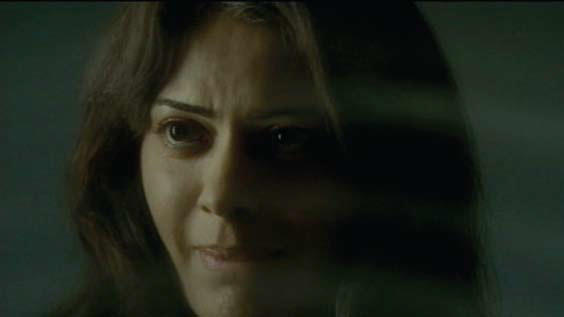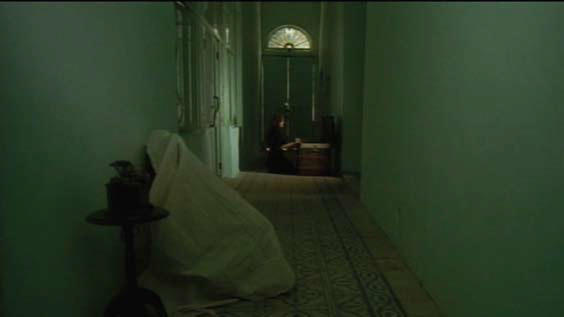
Falling from Earth, Chadi Zeneddine’s first feature film, is an intimate cinepoem that evokes Lebanon’s various wars — each of its three chapters is marked by a significant political date — through an oblique, at times surreal, inquiry. Each chapter is a portrait of a character in a discarded family snapshot gathered by Youssef (played by pioneering theater actor Rafik Ali Ahmad), an old man living alone in a semi-derelict building, who acts as a verbal and visual framing device. Zeneddine offsets any sentimental notes in the film through dry humor and minimal, wry dialogue.
Since its debut at the Dubai International Film Festival in December 2007, Falling from Earth has been screened in over twenty festivals, including the Rotterdam Film Festival and New Directors/New Films at MoMA, New York, among other festivals. The film is in general release in the Arab world in April 2009. Here Zeneddine discusses the film that has marked him as a promising new talent.
PROLOGUE AND CHAPTER 1: 1990
Youssef leads us through the film. He’s a witness to the stories in the photos that he collects and allows their subjects to lead a second life. He is the one who’s still alive, still experiencing and sharing emotions, while the other characters are trapped in the turmoil of the ongoing dilemma between life and death. At the end of the film he experiences a kind of revelation: all is here, we shouldn’t be waiting for heaven or Godot …
The Youssef scenes are filmed in a wonderful, miserable location — a school, bombarded during the civil war, in Souk el-Gharb, Mount Lebanon.
How did I cast Rafik Ali Ahmad? I used to sit at Cafe Rawda, by the sea in Beirut, where Rafik is a daily customer. This man has one hell of a look, a lion-like presence on- and offstage. I never dared to speak to him. I used to try to go up to him but end up walking past and going to the bathroom instead. In the end, I called him, and ironically we met at the same cafe. We talked for twenty minutes, and without reading the script, he told me he was in.

It took three years to make this film. My friends and I began shooting on 35mm — starting with the simple idea of three separate stories — though we didn’t have any financing. It was an adventure, which is now inspiring others.
This scene, when a random Italian actor shooting a film in Lebanon shares a cigarette with Youssef, is Felliniesque — I wanted to introduce Youssef as if he is in a kind of space that ceases to have any logical sense, time, or place. So here is this “crusader” coming to invade Beirut in the twenty-first century.
Is he, with his clichés about “bellissima” Beiruti women, the snow and sun, a portrait of the ultimate foreigner in Beirut? He’s actually the epitome of a Lebanese abroad! We are over-proud, just like the Italians. Wherever I go, we all promote Lebanon that way. The fact that it’s a foreign actor repeating those same clichés is just absurd.
CHAPTER 2: 1975
Here we have Jad, a security guard, who watches a public toilet and contributes to a graffiti chain on a toilet door. At the beginning of the scene, he seems to be burying a body, and by the end, it seems as though he’s seeing himself on the CCTV. It’s also one of my favorites, the darkest chapter in the film. He’s a witness, his past ghosts are coming back, and he seems to be letting them in. It’s the story of a young man trying to communicate his love through a restroom door. The chapter is 1975 for obvious, symbolic reasons.
We built the set for these scenes in a studio twice: the first time was at Université Saint-Joseph, Beirut. We built it all, but then didn’t receive the particular film stock I wanted and had to cancel the shooting. After six months, we rebuilt it in this warehouse with a sticky smell and roaring generators. I had to involve everyone, even my father. Funnily enough, some industry people visited our “studio,” and it’s since become one of the biggest hotels in Beirut…
In the end, it was the toughest shoot.
CHAPTER 3: 1982
Lamia’s lover “disappeared,” and she’s living with her memories. Where did we shoot the scene where she’s looking down a “tunnel”? This was a very spiritual experience, as I was in the destroyed school at twilight and felt as if I was in a mirror with an endless reflection, looking down this series of holes in the building. So I created the scene for Lamia, for her to go back in time. This location is so fitting to the film — it’s as if it were constructed or left aside especially for one of my characters.
I’m obsessed with the frame. As a filmmaker, it’s the only way you can play God! Sometimes the location would impose itself into the frame, and sometimes I would create the exact frame.
Falling from Earth is a film about impressions drawn from life rather than a narrative story. I took this “journey” because I didn’t live the wars, and I always felt weirdly guilty being excluded from it. It’s a sort of poem to myself and to my city.